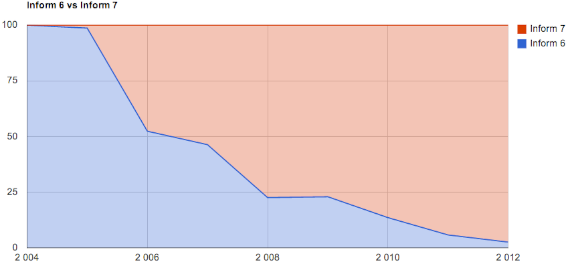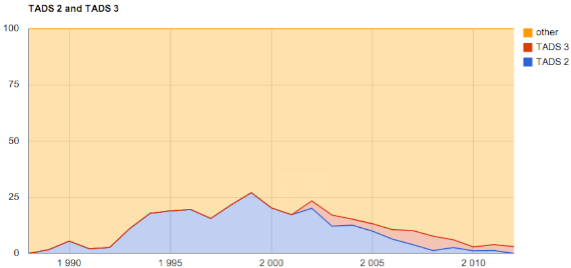Click here to read all posts from the IFDB statistics series.
When we talk about development systems in IFDB, it's good to remember that some systems have better coverage than others. Parallel communities like Quest (201 games in its own site, 26 in IFDB), non-parser systems and the AIF crowd are underrepresented. Another factor that skews statistics is that game listings tend to display the system in which the game is available now—for example Scott Adams adventures are listed as Inform 6 games because the downloads are for the Inform ports.
In the all-time popularity chart Inform 6 is the clear leader: a quarter of all games have been made with it. Inform 6 and 7 together cover more than a third of all games.
The chart for current (2010-2012) systems is a bit different. Inform 7 has risen to dominate the field with the market share of two thirds. Inform 6 has dropped significantly and all other systems are in the margins. Does this mean that the field has become less diverse or that IFDB has not kept up with new systems?
The Commercial Era
I've split the statistics in two eras: the commercial era (before 1994) and the hobbyist era (from 1994 on). 1994 marks the beginning of a renaissance—IF died commercially but at the same time the publication of Inform practically created the modern hobbyist scene.
Many of the commercial era games don't have the system marked down or have a suspicious "none" (were they written directly into machine code?) or a vague "custom". The most popular system was Eamon, which was exclusively used to create stories in the Eamon game world. The Quill was almost as popular, although the Wikipedia article says there were more than 450 commercial The Quill games (203 listed in IFDB) which would make it more popular than Eamon.
The large number of Inform 6 games is because of ports, as mentioned above.
Looking at the numbers by year, Eamon reaches quickly its highest point in mid-80s and declines from there more or less steadily. The Quill and AGT have a more steady growth all the way to the 90s. As you might imagine, BASICs popularity drops quickly after dedicated development systems become available.
Here's the same chart but with percentages from the total number of games: the vertical thickness of the area denotes more games in relation to other systems, the full height being 100%. The data in this chart goes up to 1998 so that we see how all the "old" systems drop practically to zero in popularity by then.
The Hobbyist Era
In the mid-90s the playfield changes completely. TADS, Inform, ADRIFT and other systems are released and especially Inform gains popularity.
Inform's domination is apparent in the percentual view. TADS 2 has steady popularity until the turn of the millennium when it begins a downward slope. TADS 3 gains a small foothold but never grows very much. Hugo has seen a small resurrection lately, mostly thanks to a small but active group.
Inform
After Inform 6 was released, it rose to cover almost half of all published games in only two years. The same happened when Inform 7 was released: in a few years it took the lead, eating mostly Inform 6's popularity.
This year only a handful of Inform 6 games have been released and Inform is at almost 70%.
The question is: has Inform 7 attracted people into IF who would otherwise not have done so, or would people who now use Inform 7 started to use something else if it had never been released? Surely there are people in both groups, but the graph above suggests that Inform 7 is eating away the Inform 6 userbase, not others. The "everything else" line does not seem to have any correlation with the Inform 7 line.
TADS
TADS 2 was at its height in 1999 when 27% of all games were written using it. Another peak was in 2002 after TADS 3 was released, but since then their popularity has been on a steady downward curve.
Again, the statistics show no correlation between Inform and TADS. Peaks in Inform's popularity do not show anywhere in the TADS statistics. (You could argue that I7 might have cut short TADS 3's slow climb between 2004 and 2008, but I very much doubt it.)












Anecdotally, I made an early attempt to learn IF programming with both TADS2 and I6, giving both systems a shot, and failed equally and miserably at each.
Later, I tried again with I7, and I7 worked so well for me that my plans to give TADS3 a spin have fallen into my "one of these days" bins of vague intent.
So I am at least a single isolated case of I7 attracting "people into IF who would otherwise not have done so," even to the point where I tried to get in prior to I7, and found myself unable to.
The fourth pie chart links to a line chart, which doesn't work for the data.
I remember being shocked at the revelation that 22 out of 26 games in the IFComp 2010 were written in Inform 7. At the time, I expressed fear that IF is turning into a monoculture. Since then, of course, we've seen the massive rebirth of CYOA, but there you have it.
That said, it's interesting to see that Inform 6's all-time popularity is still unequaled. Sure, it's been used as a compilation target, but I suspect that's not the main cause...
Dannii: Thanks, the link is now fixed.
I think these two graphs are very interesting too (they have the same data as some from above, but with different graph settings, can you pick which ones? :P)
http://nitku.net/if/ifdb-statistics/index.php?id=509a3c4718d47&chart=Area&stacked=1
And its simplified Inform vs everything version: http://nitku.net/if/ifdb-statistics/index.php?id=50a50f882e8fe&chart=Area&stacked=1
Those worried about Inform apocalypse should consider that 2012 has been a similar year to 1999-2000. 2001 was the peak year in total publications, as well for Inform. Yet just two years later the total publications was almost as high, but Inform's proportional was significantly smaller. Who knows what will happen next year!
If you don't know them already, you might find these two blog posts by Emily Short interesting:
http://emshort.wordpress.com/2011/01/03/scraping-ifdb
http://emshort.wordpress.com/2011/01/03/more-ifdb-data